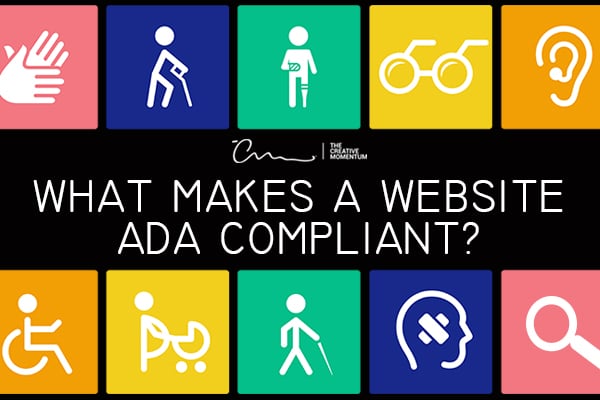
The Americans with Disabilities Act (ADA) was signed into law in 1990. It prohibits businesses and public institutions from discriminating against people with disabilities. Back in the ‘90s, this primarily led to ramps and handicapped parking spaces.
At the same time, the internet was introduced and grew as a mainstream service, necessitating accessibility standards that would allow everyone to use the worldwide web regardless of ability.
Websites aren’t optional anymore. For so many things, they’ve become the primary way to gather information, set appointments, pay bills, and contact businesses. They've become essential to modern life, and as such, need to be designed so they're accessible to all.
If your website isn’t up to ADA standards, your business could be liable for fines or open to lawsuits.
Of course, adhering to complicated government standards is never easy, so consider this your guide to making your website ADA-compliant.
What is Required for a Website to be ADA Compliant?
While a person in a wheelchair will be able to use your website without a problem, what about a color-blind person? Will he be able to see the settings and menus on your website? Can seizure-prone people navigate your website without the risk of flickering graphics or videos? Your goal is to make your website usable for as many people as possible, no matter the access challenge.
Improving accessibility has been shown over and over again to benefit more than just those with disabilities. For example, if you think about making your website accessible from a marketing perspective, you've just increased your prospective audience. The more people who can use your website, the more visitors and potential customers you’ll have! It’s an opportunity to expand your digital marketing net to help grow your business.
Website ADA Compliance and Accessibility
To maintain ADA website compliance, you need to follow the Web Content Accessibility Guidelines (WCAG). There are twelve guidelines described, but they can be boiled down to four basic principles:
- Perceivable – The content on your website is presented clearly for people of all abilities. This includes elements like alt text for images, audio alternatives for text, and high-contrast color schemes.
- Operable – Simple navigation. Not everyone can use a mouse. Your website should offer different keyboard accessibility options and voice-command navigation.
- Understandable – People can easily understand the content on your page. Make your site readable, predictable, and offer input assistance if needed.
- Robust – Your website’s content can be viewed on various devices and platforms, including assistive technologies.
Base your website design strategies on these four principles to include more people and expand your audience.
Since these four principles are rather broad, let's look at five specific elements that make up an ADA-compliant web design.
1. Readable Fonts and Image Alt Text
Text falls into the “perceivable” category of WCAG compliance. You need to make sure people of all abilities can read and see your website’s content. Use clear fonts like Open Sans, Georgia, or Quicksand and high-contrast color schemes for people with impaired vision. Don’t put yellow text on a white background. Stick with light backgrounds and dark fonts to make sure everyone can enjoy your awesome content.
For blind users, make sure you include alt text on all images. Computers can’t “read” images without it. Alt text allows site readers to describe images verbally to people who can’t see them.

2. Use Standard HTML Tags
To fulfill the “robust” requirement for ADA compliance, your website needs to be formatted so it can be read by various devices and platforms. That means coding your site using standard HTML tags.
HTML tags are how devices read your website. They’re design elements like headers, hyperlinks, and text formatting. Getting fancy with the backend website design might allow for some creative tricks, but it’ll also make it impossible for accessibility devices and software to understand your content.
Luckily, most website platforms like WordPress automatically use standard HTML tags, so you’re likely fulfilling that WCAG requirement already.
3. Include Logical Website Features
Don’t make people work to figure out how to use your website. Make it logical with standard features like a clear “X” to close out windows and labels to describe buttons and blocks. You should also design your navigation bars to be clear and easy to use.
Design your website to help visitors navigate your website and reduce user error. It will help fulfill the “understandable” WCAG requirements.
4. ADA-Compliant Graphics
![Graphics have a big impact on website ADA-compliance. [graphics] eye, keyboard, lightbulb, digital devices.](https://www.thecreativemomentum.com/hs-fs/hubfs/blog-files/2009%20batch/2009-07-WebsiteADACompliant-image-1-PerceivableOperableUnderstableRobust.jpg?width=190&name=2009-07-WebsiteADACompliant-image-1-PerceivableOperableUnderstableRobust.jpg) Graphics are a major part of ADA compliance and fall into several WCAG categories. First, be sure to include descriptions and captions for all your website images and videos. That way, site readers can audibly describe your website graphics to someone who might not be able to see them, or who chooses to load pages without images.
Graphics are a major part of ADA compliance and fall into several WCAG categories. First, be sure to include descriptions and captions for all your website images and videos. That way, site readers can audibly describe your website graphics to someone who might not be able to see them, or who chooses to load pages without images.
To be ADA-compliant, website graphics cannot flash more than three times per second. If it flashes more than that, it could induce seizures for people who are at risk.
5. Make Your Website Keyboard-Friendly
While it’s easy to take mouse navigation for granted, not everyone can use them. Some website visitors need to rely on a keyboard or other accessibility options to navigate your site.
Avoid design elements that require a mouse or touchpad to stop these features:
- Automatic scrolling
- Auto-advancing slideshows
- Videos with autoplay
If you want to include videos, slideshows, or scrolling, make sure any movement can be paused with a simple keyboard shortcut. This will help with the “operable” WCAG principle.
Achieve Website ADA Compliance with The Creative Momentum
As with any government regulation, there’s a lot that goes into making a website ADA compliant. If you’re unsure where to start, contact the experts at The Creative Momentum for a professional ADA compliance audit.
A team of professionals will examine your website to see how it compares to WCAG standards. There will also be a review from an individual who uses assistive technology for a true test to see how your website functions on various platforms and software.
Once the audit is complete, our team of experts will offer recommendations to improve your site and bring it up to ADA and WCAG standards. We can also help you implement any changes and launch your updated, ADA-compliant site.
If you want to optimize accessibility and make your website ADA-compliant, contact the experts at The Creative Momentum to get started.


